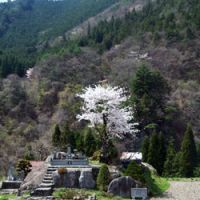Dear Alice,
On a recent train trip to Nikko, I spotted several small cemeteries in the middle of rice fields. I've also seen this from a taxi window on the way to the airport in Kanazawa. I'm guessing these little groups of graves are family plots, but why the heck are they located in the middle of rice paddies? Our taxi driver suggested it's a matter of convenience: Since the farmers are in the fields every day anyway, it's easy to visit the deceased on the way to or from work. True?
I know this is a "why the heck" rather than a "what the heck" question, but I hope you'll take it up because I'm dying to know!
Doc O., Machida, Tokyo
Dear Doc,
After a bit of digging, I decided to take your question to Hajime Himonya, managing editor of SOGI, The Magazine for Funeral Service (Sogi is a relatively formal word for "funeral.") Himonya said what you saw were probably kyodo bochi (common graveyards) that are shared by a small rural community.
Although such cemeteries exist in many parts of Japan, they are particularly prevalent in the Hokuriku region, which includes Fukui, Toyama and Ishikawa prefectures, so he wasn't at all surprised that you had spotted one near Kanazawa.
"Although the disposition of human remains is now regulated, until after the war, people were free to erect graves pretty much wherever they wanted," Himonya explained. "Family plots might be placed very close to the home, but if a graveyard was to be used by an entire village, it was usually situated in a place that was convenient and meaningful for the community.
"The rice fields were where people came together to work and grow their sustenance, so that would be a logical place for their graves."
When I wondered if that wasn't a little too close for comfort, Himonya pointed out that Japanese people used to have a much closer relationship with death.
"In earlier times, death was more clearly regarded as a part of life," he said. "Graves weren't scary, particularly for people in rural areas, because you would know everyone who was in there."
Some of these small cemeteries are still in use, and local people, or those with family connections to the graveyard, can arrange to have their remains added to the common grave. In other cases, the communities themselves have died out as younger residents moved away to the cities.
As an aside, you might be interested to know that nearly all human remains in Japan are now cremated (the figure recently hit 99.9 percent). People often assume that the custom of burning bodies came to Japan with Buddhism in the eighth century, but archaeologists working near Osaka have uncovered burned human remains that date back several centuries earlier.
Yet, despite this long history of cremation, burial was also a common practice in many parts of the country until fairly recent times. Bodies were bound into a sitting position, which saved on both burial space and wood for the coffin in which the body was placed before burial. The same position used to be common for cremation (kaso) too, perhaps to use fuel efficiently.
These days, it is usually only Muslims who are buried in Japan (because Islam prohibits cremation), and very few cemeteries are set up to accommodate burials. Japanese Christians are almost always cremated, even though the Vatican didn't sanction cremation until 1963, well before that many Catholics in Japan found that the lack of burial space and the local preference for cremation made it necessary to cremate their dead.
Before I departed, I asked Himonya about new trends in the funereal industry. A relatively new practice, he said, is sankotsu — scattering the ashes of the deceased in places of natural beauty. Although the relevant laws don't specifically mention scattering, regulators have determined that it's not illegal as long as the remains are finely ground (not the norm in Japan, where bones are picked out of the cremated remains as a standard part of funerals), and scattered in such a way as not to cause trouble for anyone. There are even commercial services that will scatter Japanese remains in California or New Zealand.
Another new development is jumokuso (funerals in the trees), in which temples and other providers of grave space offer a final resting place among woods and wildflowers. A temple in Iwate Prefecture that claims to have been the first in Japan to offer this service, in 1999, accepts cremated remains for ¥500,000, a fraction of the cost of a regular grave in Japan. Grave stones are not allowed, and only flowers or trees can be used to mark the grave site.
In last month's column about the sometimes annoying tinkling of bells, I invited readers to write in about other noises in Japan that really burn them up. Here's a sample from my mailbag: loud squeaky bicycle brakes; well-meaning but maddeningly repetitive safety warnings such as those played near escalators; otherwise considerate neighbors who start their day at dawn by slamming open their window shutters; and incessant sniff-sniffing by people who are too polite to blow their noses in public.
Also, the racket spilling out of pachinko parlors; talking ATMs; and tape players blasting out sales pitches as heard in some supermarkets and all Don Quijote stores.
For balance, one reader sent not only his complaints but also a list with the charming title "Top-10 Sounds That Make my Day," which includes the thump-thump of rice being pounded into mochi. Now how about that for ending on an agreeable note?

















With your current subscription plan you can comment on stories. However, before writing your first comment, please create a display name in the Profile section of your subscriber account page.